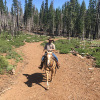Jim Watson
Member
In Town:
IWB or in a pants/coat pocket.
I recall a reprint of an article from the Sacramento Bee about the gold/silver mining town of Bodie, California.
Army and Navy revolvers in belt scabbards are seldom seen, the usual weapon is a Bulldog revolver in a leather or canvas lined coat pocket.
The Bee also said Bodie was known as Bad Shot Gulch because of the large number of gunfights with no casualties. It recounted one incident with many shots fired, the only injury being the cigar shot out of the bar piano player's mouth in the opening volley before he took cover.









